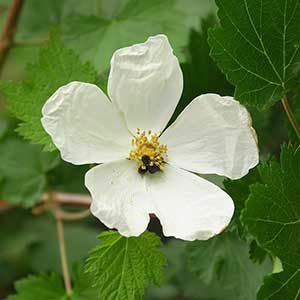Rubus bartonianus
Rubus lasiococcus
Barton's raspberry, bartonberry
dwarf bramble, hairy-fruit smooth dewberry, rough fruit berry, roughfruit raspberry
erect, sparsely short-hairy, glabrescent, eglandular, not pruinose.
creeping, flowering branches erect, sparsely hairy, eglandular or sparsely to moderately short-stipitate-glandular, not pruinose.
deciduous, simple;
stipules lanceolate, 4–6 mm;
blade cordate to broadly ovate, (2–)2.5–4(–5) × (2.5–)3.5–4.5(–5.5) cm, base deeply cordate, 3–5-lobed, lobe apices acute to obtuse, margins coarsely doubly dentate, abaxial surfaces glabrous or sparsely hairy, eglandular or sparsely stipitate-glandular.
deciduous, simple or ternate;
stipules broadly elliptic to ovate, 5–10 mm;
leaflets 3(–5), blade reniform or orbiculate, terminal lobe or leaflets broadly obovate to obovate-cuneate, 1.5–4(–6) × 1.5–4(–6) cm, base cordate, 3(–5)-lobed, margins coarsely doubly dentate, apex rounded to acute, abaxial surfaces sparsely hairy on veins, eglandular.
1-flowered.
1–2-flowered.
moderately hairy, eglandular or sparsely stipitate-glandular.
sparsely to moderately hairy, short-stipitate-glandular.
bisexual;
petals white, obovate, (15–)20–25 mm;
filaments filiform;
ovaries glabrous, styles clavate, villous.
bisexual;
petals white, broadly elliptic to obovate to orbiculate, (5–)8–10(–12) mm;
filaments filiform;
ovaries densely hairy, styles filiform, glabrous.
deep red, hemispheric, to 1 cm;
drupelets 10–30, coherent, separating from torus.
red, hemispheric, 1 cm;
drupelets 5–15, weakly coherent, falling separately or as loose units free from torus.
= 14.
Rubus bartonianus
Rubus lasiococcus
Of conservation concern.
Rubus bartonianus is distinguished from the other flowering raspberries within its geographic range by its erect, unarmed stems, relatively small, simple leaves with acute to obtuse lobes, deeply cordate bases, sparsely hairy or glabrous abaxial surfaces, relatively large flowers with white petals, and densely long-hairy, clavate styles. The leaves superficially resemble those of Acer glabrum or some species of Ribes.
Rubus bartonianus is most similar to R. neomexicanus but especially R. deliciosus. The species is known only from the Snake River Canyon of Idaho and Oregon.
(Discussion copyrighted by Flora of North America; reprinted with permission.)
Rubus lasiococcus is recognized by its creeping, unarmed stems, simple 3-lobed to 3-foliate leaves, small flowers, white petals, and densely hairy ovaries.
(Discussion copyrighted by Flora of North America; reprinted with permission.)
- Local floras:
BC,
CA,
OR,
WA
- Local Web sites:
CalFlora,
CalPhotos,
Flora NW,
PNW Herbaria,
Turner Photog.
WildflowerSearch
iNaturalist (observations)
USDA Plants Database
- LBJ Wildflower Center
- SEINet
- Plants of the World Online
- Encyclopedia of Life
- Wikipedia
- Google Image Search


